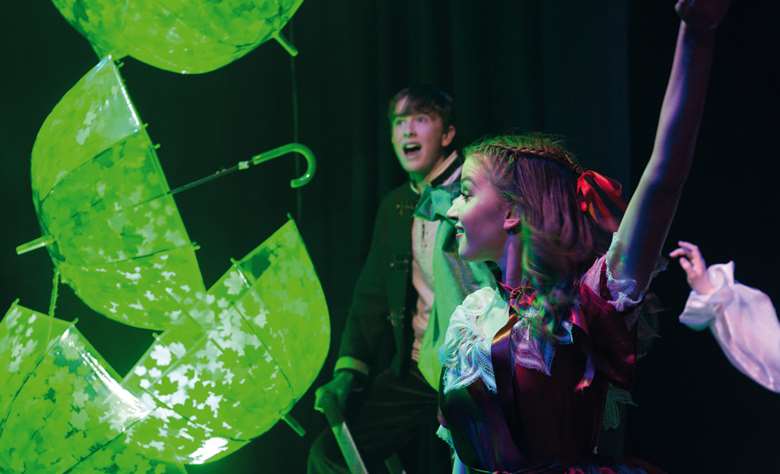Play for performance: Into the Woods JR.
Victoria Harrocks
Thursday, October 22, 2020
Each issue of D&T we bring you a page-to-stage focus on a play for performance with your students. This issue, Victoria Harrocks, Creative Arts Coordinator at Formby High School, conjures up her diverse and inclusive performance of musical fairy tale 'Into the Woods JR.'

CLARE WILKINS
Set in a fairy-tale kingdom, Into the Woods JR. reimagines the Brothers Grimm tales with their narratives intertwined, and the various plots are tied together by a Narrator. The story centres around a Baker and his wife who wish to have a child and to do so must undo a witch's curse. James Lapine and Stephen Sondheim's musical is one gigantic fable which visits key themes of wishes, the pursuit of dreams and their consequences. Through a series of adventures and encounters with fairy-tale heroes and villains, the characters enter a journey ‘into the woods’, confronting their issues and the fallout from their mistakes.
A satisfying conclusion
If you are familiar with the full version of Into the Woods, Act 1 completes when everyone has achieved their wish and will by all appearances live happily ever after. Act 2 deals with some disastrous behaviour and sinister consequences. Music Theatre International has adapted this Junior Broadway show to finish at the end of Act 1, making this a one hour long, one act show. The integrity of the show is upheld as the characters’ wishes and quests are explored; the show neatly concludes when the characters have learnt life lessons and restored their community.
The MTI Junior Broadway library contains musical theatre show packages made to suit an amateur youth company or school cast. Songs are shortened and key changes simplified to make the performance more achievable for young singers. Even so, the show is musically challenging – an experienced MD is vital. However, MTI provides essential materials to support you. These include a rehearsal CD and tracks that can be used in performance. The cast script is user-friendly for young performers and the Director's script includes helpful staging tips.
Innovative staging
Our version of the show was created for a promenade (no seating) in-the-round performance at our local library. We wanted to show support to our local library, amid many closings, and highlight the importance of theatre, cultural heritage, and literacy. Our vision was to bring the community together to see, hear and read stories, showing that local spaces can become alive with creative situations. We drew parallels between show themes and our own reality that the community must come together to save important parts of our kingdom. We also planned for a performance in our school studio theatre – our approach needed to work for both locations.
Sondheim's musicals often lend themselves to the bending of time and place in theatrical setting and design. Inspired by our library setting, the props were painted onto the covers of books, for example, the ugly sisters used a large book backed with a mirror. Likewise, the witch's garden (which she raps about in the opening section) was created with beans and vegetables painted onto books. Many donations of shockingly bad bridesmaid dresses worked a treat in creating fantasy costumes.
With no wings or backstage area in the library, we decided to position our actors onstage the entire time. Physical theatre is used to make the set – the characters created the scenery. Examples include Rapunzel's tower and the cast holding bedsheets, pillowcases, and a cup and saucer depicted Granny's bedroom. The benefits of this approach include engaging all cast members during rehearsals, the possibility of quick scene changes, and of course a human set is free of charge; an important factor in a low budget school performance. Through physical theatre we encouraged new experiences, crucial to the well-being and creative engagement of non-lead actors. Furthermore, we were able to augment the cast size by including additional ensemble, which is an important factor in youth and school theatre.
Defying stereotypes
By examining this society of fairy-tale characters, cross curricular links were discovered aligning to PSHE. Our cast debated how their artistic practice could be used as a tool to emphasise diversity, equality, and inclusion. We cast the princes as female noting that not all girls want to be saved by the prince nor become a princess. The list of items required to break the spell is repeated throughout the show, so the entire company incorporated BSL to include our deaf community. This idea was particularly successful and became part of the choreography which gave our show spellbinding visual impact.
Our production team featured a mix of teachers and students. If you can link your show to a qualification like the Arts Award, students can offer valuable assistance while completing their final project. Our lighting and sound technician achieved Silver and an SFX makeup artist achieved Gold Arts Award from working on this show. We have successfully worked with several MTI Junior titles and our annual musical theatre show is a highlight of the school calendar. Show package materials guide and support the user clearly through the process and are well worth the cost. For cast and crew, it was a thrilling adventure journeying ‘Into the Woods’.
Into the Woods JR. can be licensed for performance from Music Theatre International, by going to www.mtishows.co.uk/into-the-woods-jr

